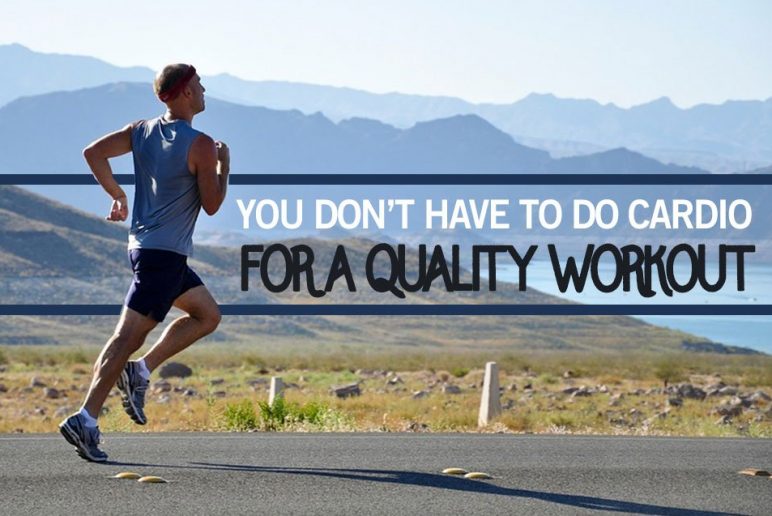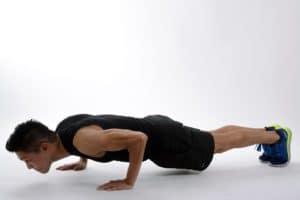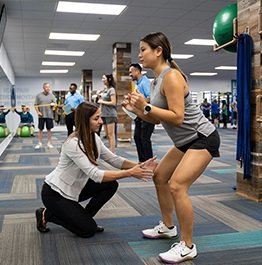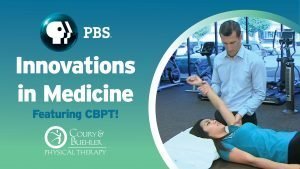
Dispelling Myths: You Don’t Have to do Cardio for a Quality Workout
December 07, 2017Treadmills, ellipticals, bikes, rowing machines… Gyms and fitness centers are littered with “cardio” equipment. But is it really necessary to incorporate these machines or similar activities into a workout routine?
It always is going to end up depending upon your fitness goals, but to better understand whether or not you should be spending all that time running in place, let’s consider the components to fitness, as listed in the image below:
Cardiorespiratory Fitness
Previously referred to as cardiovascular fitness, cardiorespiratory fitness includes not only efficiency of heart function and blood flow, but also the ability to use the oxygen delivered via breathing and blood flow. This is the component that is going to be most exercised by those “cardio” machines and activities, as the name suggests. When you apply repeated sustained stress to your musculoskeletal system via exercise, your heart has to start pumping harder to send fresh blood to the affected tissues that are accumulating the stress and byproducts, such as lactic acid, secondary to the activity.
 The heart works in conjunction with the lungs. The heart is the pump that cycles used blood and refreshes it by allowing for cellular respiration in the lungs; accordingly, as the heart works harder, breathing has to increase, too. As you continue to train this system, efficiency of breathing and pumping improves such that your body will be more effective in allowing for that transfer without needing to increase the systemic work rate, i.e. lower pulse and steadier breath, as much for a comparable activity as before.
The heart works in conjunction with the lungs. The heart is the pump that cycles used blood and refreshes it by allowing for cellular respiration in the lungs; accordingly, as the heart works harder, breathing has to increase, too. As you continue to train this system, efficiency of breathing and pumping improves such that your body will be more effective in allowing for that transfer without needing to increase the systemic work rate, i.e. lower pulse and steadier breath, as much for a comparable activity as before.
It is important to note that any activity that provides sustained musculoskeletal stress at an appropriate intensity when you notice an increase in breathing or heart rate can train the cardiorespiratory system, and therein lies the rub relevant to the myth above. Specifically, it is possible to train “cardio” without doing “cardio”, or to be clearer, as long as your physical activity is sustained stress that challenges your heart rate and respiration, it qualifies as cardio. Therefore, simply weight training at a consistent rate throughout or playing whatever your sport may be can be challenging enough for cardio.
Muscular Strength

Strength is generally defined as maximal output within one repetition. This component is generally trained with increasing resistance (or weight). It can be built more specifically by training fewer reps in a given set.
Muscular Endurace

Different from cardiorespiratory fitness but similar in concept, this refers to your muscle’s ability to endure sustained or continual load across a span of time. Accordingly, this component is trained more specifically with a greater number of reps in a given set.
Flexibility

Flexibility refers to general ability to achieve greater ranges of motion. Flexibility can refer to muscle length, but it may also refer specifically to a joint. There is a “normal range” for joints to be able to move, and shortages in those respective ranges can occur either at the joint level or the surrounding muscles. Stretching can generally address these deficits, but definitely consider paying us a visit to help you determine what structures are more limited.
Body Composition
The most common way of measuring body composition is BMI, which measures a relative ratio of height to mass/weight; however, this is not necessarily the most accurate in terms of measuring health and fitness. Body composition also refers to how well balanced an individual is in terms of maintaining all of the other components of fitness – that is, how well conditioned are the muscles and cardiorespiratory systems for endurance and strength? A person who is dense in muscle will likely be heavier than an individual of the same height with more fat, for instance, especially since muscle is heavier than fat. To better measure something like fat content, you may choose to consult a fitness professional for a skinfold assessment.
Skill-related Components
I won’t go into detail about agility, balance, power, speed, coordination, and reaction time because they are generally more relevant specific to whatever skills are required for your given activity or sport. They are certainly important considerations in your training, though, so be sure to incorporate those aspects into your workouts.
So what should you do?
Again, it ultimately depends upon your goals. A general principle to consider is the SAID principle, which stands for specific adaptation to imposed demands. This basically means that whatever you train is what your body will adapt to. So, if you are training for a specific sport, definitely train in a way that is relevant to the skills required for that activity or sport.
If you decide to do weight training, something to consider is how much resistance to use for a given exercise. First, you’ll need to decide what you’re going to train, i.e. strength/power, hypertrophy/size, or muscular endurance/toning, which will dictate your sets and reps. The amount of weight will vary depending upon the muscle group and form of training, but once you’ve decided on sets and reps, you’ll be able to determine resistance as fatigue should be experienced toward the end of a given set. Accordingly, heavier weight / more resistance with fewer reps and lighter weight / less resistance with increased reps.
If you have any questions or would like to share your workout routines, feel free to comment in the discussion below!
Schedule a FREE Assessment with Charles today!
Get more wellness tips sent straight to your inbox!
Sign up for Life+!
Charles’s primary hobbies include playing badminton, playing modern tabletop (board) games, hiking (especially if there’s a water destination along and/or at the end of it), and participating in cooperative interactive challenges such as escape rooms. He also values practicing yoga and swimming as well as more interactive physical activities like playing basketball and rock climbing with friends. He has been known to dabble periodically in obstacle course race events. Eating food is certainly one of his favorite things to do, too.
Latest posts by Charles Wang, PT, DPT (see all)
- Can You Target Fat Loss? - September 13, 2021
- How Does Your Balance System Work? - August 19, 2021
- Dispelling Myths: Yoga is More than Just Stretching - June 20, 2019
- Buffet Binging: Helpful Tips to Practice Self-Control - March 23, 2018
- Cross-Training vs. Single-Sport Training: Which is Better? - January 02, 2018
- Dispelling Myths: You Don’t Have to do Cardio for a Quality Workout - December 07, 2017
- Dispelling Myths: You Don’t Have to Look Good to Feel Good - November 09, 2017
- Maintaining a Healthy Work-Life Balance - November 01, 2017
- Dispelling Myths: Dieting Does Not Mean Eating Less - October 02, 2017
Reader Interactions
Leave a comment Cancel reply
You must be logged in to post a comment.
SIGN UP FOR
LIFE+ is a FREE membership
that offers:
• Informative Newsletters
• Health & Wellness Tips
• Videos from Our Experts
• Special offers
…and much more!
SEARCH

GET MORE TIPS! PAIN 101 TUTORIALS
EXPLORELATEST TWEETS
ARCHIVES
- February 2025
- August 2024
- February 2024
- November 2023
- September 2023
- July 2023
- June 2023
- January 2023
- November 2022
- October 2022
- September 2022
- August 2022
- July 2022
- June 2022
- May 2022
- April 2022
- March 2022
- December 2021
- November 2021
- October 2021
- September 2021
- August 2021
- July 2021
- June 2021
- April 2021
- March 2021
- February 2021
- January 2021
- December 2020
- November 2020
- October 2020
- September 2020
- August 2020
- April 2020
- March 2020
- February 2020
- January 2020
- December 2019
- November 2019
- October 2019
- September 2019
- August 2019
- July 2019
- June 2019
- May 2019
- April 2019
- March 2019
- February 2019
- January 2019
- November 2018
- September 2018
- August 2018
- July 2018
- June 2018
- May 2018
- April 2018
- March 2018
- February 2018
- January 2018
- December 2017
- November 2017
- October 2017
- September 2017
- August 2017
- July 2017
- June 2017
- May 2017
- April 2017
- March 2017
- February 2017
- January 2017
- December 2016
- November 2016
- October 2016
- September 2016
- August 2016
- July 2016
- June 2016
- May 2016
- April 2016
- March 2016
- February 2016
- January 2016
- December 2015
- November 2015
- October 2015
- September 2015
- August 2015
- July 2015
- June 2015
- May 2015
- April 2015
- March 2015
- February 2015
- January 2015
- December 2014
- November 2014
- October 2014
- September 2014






